Mom and I decided to visit Japan this summer - our maiden visit to the Land of the Rising Sun. Since we were traveling independently, I did some research before our departure. This was part of the adventure, and I enjoyed planning what to see, where to go, and what to eat/buy.
After booking our flights and hotels, I also booked (and prepaid for) a business pocket WiFi. I chose the most popular Japan Wireless Business (Pocket) Wifi rental for 11 days with pick-up from NRT on July 1st and drop-off (via mail) on July 11th. The discounted rental rate (with a coupon code) for 11 days was just US$50.80 (¥6,936), and it included a Softbank 4G LTE device (up to 5 connectivity), free power bank, unlimited data, and a download speed of 95 Mbps.
I also exchanged USD to Japanese Yen while I was in Singapore. The market rate turned out to be 1 USD to 141.88 JPY. It was a really good rate and the best time to visit Japan.
Day 1: Saturday, July 1
Our Scoot flight landed at Narita International Airport (NRT) at 6:15 a.m. After clearing immigration and customs, we made our way to the low-cost airport bus counter, located directly in front of the customs exit in Terminal 1. We waited about 15 minutes for the counter to open at 7 a.m. The fare to Tokyo Station was just ¥1,300 per adult ($9.16). We selected the earliest departure at 7:40 a.m. for a swift start.
Then we walked to the JAL ABC counter in the left South Wing domestic area, on the same concourse, to pick up our Business Pocket WiFi rental. The envelope included everything needed: WiFi device, charger, power bank, pouch, return envelope, and easy-to-follow instructions.
On the walk back to bus platform 7, we grabbed breakfast from the airport: 2 egg salad sandwiches (¥476; $3.35), 2 green tea drinks (¥256; $1.80), and a plastic bag (¥3;$0.02). The total was ¥793 ($5.59). While waiting, I activated the WiFi, which connected smoothly after a few minutes.
The airport bus ride took just one hour (7:40-8:40 a.m.), and we slept through most of it. The bus was clean, and the ride itself was efficient and cost-effective. I'd highly recommend it - it was far more economical than other bus options, trains, or taxis. Luggage could be stored either in the overhead compartments or in the undercarriage storage, making the journey comfortable and hassle-free.
We arrived at Tokyo Station to a rainy Saturday morning. While there, I purchased 2 Shinkansen (bullet train) reserved tickets to Kyoto for July 5th, traveling aboard Nozomi 27. The cost was ¥13,970 ($98.46) per passenger, and our scheduled departure from Tokyo Station was 12 p.m., arriving in Kyoto city zone at 14:15.
Next, I registered Suica cards for mom and me, depositing ¥2,000 ($14.10) on each. A ¥500 ($3.42) fee was automatically deducted as the card deposit. We used the Suica card extensively throughout our trip - for metro and bus rides in Tokyo, Kyoto, and Osaka. Topping up was easy at station machines, which made navigating city transport smooth and convenient.






We walked about 15 minutes from Tokyo Station to Hotel Sardonyx Tokyo. On the way, we popped into our first convenience store (Lawson) for a cup of coffee and to rest and shelter briefly from the rain. Mom bought a long black umbrella for ¥1,650 ($11.63)!
From there, we walked just a few more minutes to Hotel Sardonyx Tokyo, arriving shortly after 10 a.m. - way too early for check-in. We left our bags at the reception and headed out, undeterred by the rain, to explore Ameyoko.
We took the metro to Ameyoko Plaza, nestled in the vibrant Ameya Yokocho neighborhood - a bustling market street known for bargains and street food, set in the traditional, historical district of Ueno in northern Tokyo. It was a short 3-minute walk from our hotel to Hatchobori Station, where we boarded the grey Hibiya Line heading toward Naka-Okachimachi Station. The total commute took around 12 minutes, quick and efficient.
From Naka-Okachimachi Station, we walked about 5 minutes (450 meters) to Yatai Hamachan, drawn by its reputation for quality food at reasonable prices. We waited in line for 30 minutes before its opening at 11:30 a.m. This was our introduction to the Japanese culture of patiently lining up for food. By the time the doors opened, we were tired and famished.
The interior was small and rustic. The young team of servers and cooks worked hard with quiet efficiency and polite enthusiasm. Without needing to ask, one of the servers kindly handed me an English menu, making the experience welcoming for newcomers.
We ordered a delightful spread:
- Grilled scallop with butter (¥500)
- Assorted sashimi - 3 kinds (¥950)
- Tempura - crispy, golden selections
- Kaisen bukkake don - a raw fish rice bowl (¥650)
Feeling pleasantly stuffed after lunch, we set off in search of a new medium-sized check-in luggage. Though we passed many stalls brimming with fresh seafood, our appetites had already surrendered. After browsing through several shops, we finally chose one west of the train tracks that offered the best tax-free prices. I picked out a luggage with a TSA lock for ¥6,980 ($49.20) and a Converse bag for Dad for ¥6,210 ($43.77) - both great value finds.
A short stroll later brought us to Mihashi Ueno Main Shop, known for its classic Japanese sweets and various kinds of anmitsu. As expected, there was a line to sit down, but it was worth the short wait. The anmitsu with matcha ice cream was really delicious. Every bite was flavorful - from the anko red bean to the sweet mandarin orange, chewy mochi, and silky jello with rich black honey, all crowned by the slightly bitter elegance of matcha ice cream. It was truly heavenly.
The second dessert, however, a cold, salty, soy-based jelly-type noodle, was far less appealing. The texture and flavor didn't quite resonate with us, but it was a memorable culinary experiment. We spent a total of ¥1,320 ($9.30) for both desserts.
By 2 p.m. we'd finished our desserts and ready to catch the metro back to the hotel. The rain had lifted, and the city basked in gentle sunlight. We were able to check in ahead of schedule at 2:20 p.m., as Room 615 was already prepared. I paid ¥54,842 ($386.54) for our 4-night stay. It was a corner room at the end of the hallway - spacious, modern, and quietly tucked away. We showered, slipped into our hotel pajamas, and rested for the remainder of the day - grateful for the pause.
At 7 p.m., we ventured across the street to Lawson for dinner, picking up an assortment of goodies totaling ¥2,519 ($17.75). We fumbled with heating up the food as the microwave instructions were all in Japanese, and the numbers for heating times didn't quite match up. A young man nearby offered help, speaking enough English to guide us through. I quickly noticed that younger Japanese seemed more comfortable with English, a subtle generational shift in language fluency that revealed itself in daily interactions.
Day 2: Sunday, July 2
At 7 a.m., we started our day with a simple hotel-room breakfast: 2 drip coffees, last night's convenience-store tuna salad mayo onigiri, and 2 soft-boiled eggs. They were so delicious! The eggs were perfectly seasoned - the creamy, slightly salty yolks unlike anything I'd tasted before. The tuna onigiri was flavorful too, its savory filling wrapped in delicate rice and seaweed.
After breakfast, the comfort of our hotel pajamas and the stillness of the morning drew us back into rest. We dozed off again and woke around 8-ish, recharged and ready to ease into the day.
At 9 a.m., we took the metro to Misojyu in Asakusa for breakfast round two - a miso soup and onigiri combo in a warm, sunlit pocket of Tokyo. Unsurprisingly, there was a long line of guests waiting to dine-in, but at least the weather was bright and cheerful, lifting the mood as we waited our turn.
We managed to snag seats for their final breakfast service at 10 a.m., which typically starts at 8 a.m. Each breakfast set cost ¥770 ($5.43) and included a bowl of miso soup, one onigiri, and half a soft-boiled egg.
Despite the quaint presentation, Mom wasn't too impressed. She preferred the tuna mayo onigiri and soft-boiled eggs we'd had earlier in the hotel room - simple convenience-store fare that outshone the curated cafe experience. I agreed with her, but I appreciated the ambiance nonetheless. The upstairs dining area was decorated in Japanese calligraphy, adding a touch of traditional beauty that made the visit worthwhile.
Then we walked toward Sensoji Temple, Tokyo's oldest and most iconic temple, built in 645. As the symbolic heart of Asakusa, it stood quietly ahead of us while the streets buzzed with life. The path there was lined with artisanal shops, souvenir stands, and restaurants - a true feast for the senses. There was so much to see, buy, and taste in Asakusa!
Mom found great deals on shoes and bags, while I picked up two handbags for just ¥1,300 ($9.16) and a fridge magnet for ¥200 ($1.41).) Mom also bought a few snacks and accessories.
To cool down and treat ourselves, we stopped at Canele et Creme Glacee for ice cream. We chose the café chocolate and banana honey & almond flavors - both were delectable: creamy, fresh, and perfectly sweet without being overwhelming. Each scoop cost ¥480 ($3.38).
After taking the obligatory photos of Sensoji Temple, we strolled down Nakamise-dori Street, the lively pedestrian lane that links the temple's main hall, main gate, and Kaminarimon Gate. The street was buzzing with both locals and tourists - many dressed in rental kimonos, adding an extra splash of tradition to the sunny midday atmosphere.
It was almost noon, and the heat nudged us toward a sweet reprieve. At Ginkado Asakusa, their strawberry daifuku mochi caught our eye - each one priced at ¥400 ($2.82). We bought two: custard and green tea. The mochi was soft, the filling rich and flavorful, and the fresh strawberry perched on top was bright and sweet - SO good! To cool off further, we shared a refreshing iced orange soda water for ¥700 ($4.93) - crisp, light, and exactly what the moment called for.
At the Kaminarimon Gate, we saw several young rickshaw drivers actively seeking customers. They looked incredibly fit and energetic, ready to pull visitors through Asakusa's historic streets. We passed on their service and continued on foot toward the Sumida River.
Along the way, we paused often to take photos of the Tokyo Skytree, Japan's tallest tower, looming in the background. We opted not to visit it - we're not fans of towering structures.
During our walk, we stumbled upon Asahi's headquarters and its infamous Golden Flame sculpture on the top of the building. It's meant to represent a blazing flame of innovation, but frankly? To us, it resembled something far less majestic... something straight out of the litter box, if I'm being honest.
We strolled along the river and found a shady bench to rest on, enjoying the cool breeze and peaceful view. After a packed morning, this quiet moment beside the water was just what we needed.
After resting on the bench by the river, we meandered back toward the shopping area and found another sanctuary from the summer heat: Coffee Shop Carib. The moment we stepped inside, the strong air conditioning swept away our fatigue, offering instant comfort.
I ordered an iced Viennese coffee, while Mom had an iced lemonade. We also shared their large flan, served with whipped cream, mandarin oranges, pineapple pieces, and topped with a bright cherry. It was sweet, nostalgic, and just the right kind of indulgence.
Their service was impeccable - as soon as we sat down, the staff presented us with a glass of iced water and a wet towel to refresh our hands. The decor leaned retro, but was cozy and welcoming. It wasn't your typical Starbucks, and that made all the difference. I genuinely enjoyed my time there. We spent about ¥2,250 ($15.86), and it felt like money well spent on comfort and charm.
Next, we found our way to Rox shopping mall and Asakusa Rox just across the street. We spent most of the afternoon enjoying ourselves in both spaces - an impressive range of shops and brands under one roof. From favorites like Muji, Daiso, 3Coins+, and Honeys discount store to smaller boutiques, a bookstore, and even a mobile service provider, the variety kept us happily engaged.
It was my first foray into a distinct aspect of Japanese shopping culture: removing shoes in the fitting room and wearing a face cover while trying on clothing to avoid staining the items. A thoughtful practice that made me admire the level of detail and respect woven into everyday experiences.
By 3:30 p.m., we wrapped up our shopping and walked about 10 minutes to Otafuku for an early oden dinner. The restaurant opened at 4 p.m., and we were their first customers of the day. With over a century of history, Otafuku is known for using the same broth since 1945 - a legacy steeped in tradition.
We ordered a mix of items: daikon, cabbage rolls, egg, fried tofu, and squid ball. Including an appetizer and green tea, the total came to ¥5,440 ($38.34).
Was it worth it? I'd say yes - for the novelty of dining in a storied establishment. But would I return for the food alone? Probably not. While the ambiance and legacy were memorable, the broth lacked depth and most ingredients tasted rather flat or bland. For a local craving oden, it might feel overpriced, especially with the add-ons.
We walked another 10 minutes to Inari Station to catch the grey Hibiya Line back to the hotel after dinner. Along the way, we stopped into Lawson - again - for next day's breakfast. We picked up our usual favorites: 2 tuna and egg salad sandwiches (¥558 or $3.93), a tuna salad onigiri (¥135 or $0.95), and 2 bottles of chilled café latte (¥300 or $2.11). The total came to ¥996 ($7.02), including a plastic bag (¥3 or $0.02). Sadly, the soft-boiled eggs were sold out - a little disappointment in an otherwise well-oiled routine.
Day 3: Monday, July 3
Next, we walked about 3 minutes (270 meters) to Shibuya Loft for another round of shopping. It was a visual feast - from the meticulously arranged stationery in the basement to the delightful showcase of Zakka culture on the top floor, celebrating Japan's unique appreciation for cute and stylish everyday knick-knacks.
After exploring the multi-floor wonder, we decided to call it a day. We were too tired to lug around a huge bag of purchases, so we returned to the hotel and enjoyed a quiet couple of hours of rest in the room.
At 5 p.m., we left the hotel and walked about 15 minutes to Tokyo Station for kaiten sushi dinner at Sushiro Yaesu Underground Shopping Mall. The entire process - from entering party details and getting seated, to ordering and paying - was fully automated, making everything smooth and easy.
There was no wait at all; we sat down at table 33 immediately after checking in. The sushi was fresh and a great value at just ¥150 per basic plate (typically 2 pieces each). We ate to our heart's content, enjoying 12 items in total, and paid just ¥2,210 - a budget-friendly and delicious meal.
After dinner, we made our way to Shinjuku, which truly comes alive at night under a flood of neon lights. Our first stop was Omoide Yokocho, also known as Piss Alley - a narrow, old-fashioned izakaya alley strung with lanterns. Mom wasn't impressed by the so-called Memory Lane. It was cramped, smoky, and we were both glad we'd eaten beforehand.
Then we ambled to Kabukicho, Tokyo's red light district, lit up with colorful neon signage at every turn. The area definitely wasn't our cup of tea. I couldn't help but wonder if the bright neon lights were an attempt to mask - or compensate for - the darker realities hidden behind love hotels and karaoke joints.
As we meandered back toward the metro, we serendipitously stumbled upon 2 iconic displays: a looming Godzilla peering from a rooftop, and the playful 3D calico cat (Kyodai Mikeneko) perched on the Cross Shinjuku Vision billboard. The cat's lifelike appearance was mesmerizing.
On the way back, we came across Giolitti in Shinjuku Station, but it turned out to be a disappointment. The gelato was insanely expensive and unappetizing - two cones with two flavors each cost ¥1,944!! The shop itself was hot and stuffy, with hardly any seating available. I had to stand until a couple vacated their stools. For the price and experience, I definitely wouldn't recommend it.
It had been a long, tiring day. After picking up breakfast items from Family Mart, located diagonally across from the hotel, we returned to our room, completely bushed.
Day 4: Tuesday, July 4
- Tamago for ¥150 each
- 2 packs of green tea powder for ¥760 each
- Saba (¥800) and Akou (¥900) meal sets with green tea for ¥1,900
- A dorayaki filled with red bean paste and apricot for ¥300







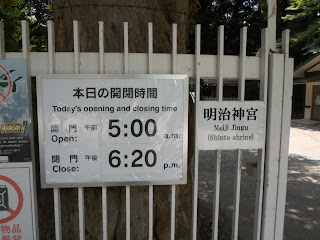









































































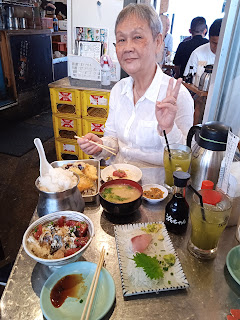






























































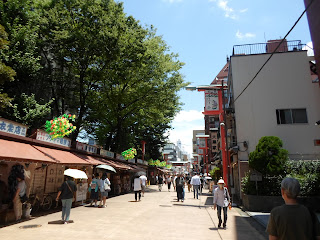




























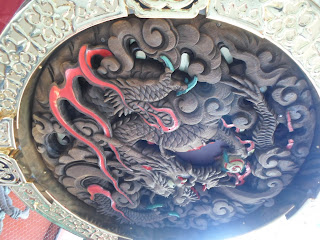













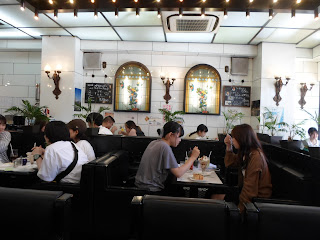










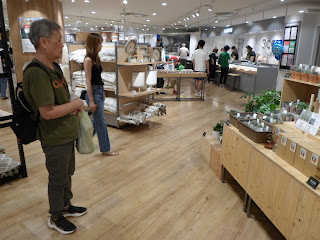










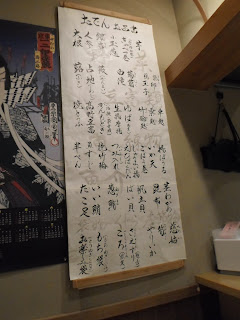

































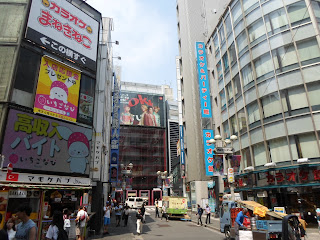




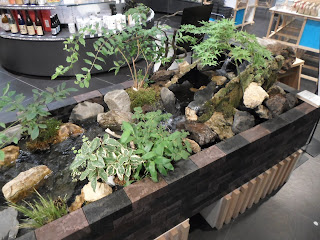
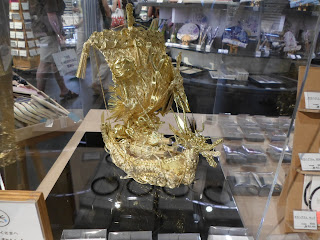
































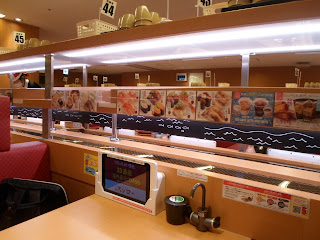

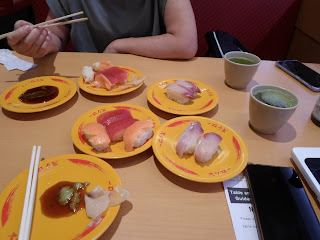































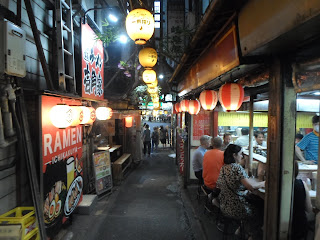

















































































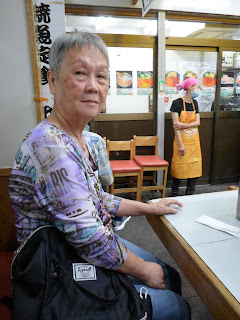










































No comments:
Post a Comment